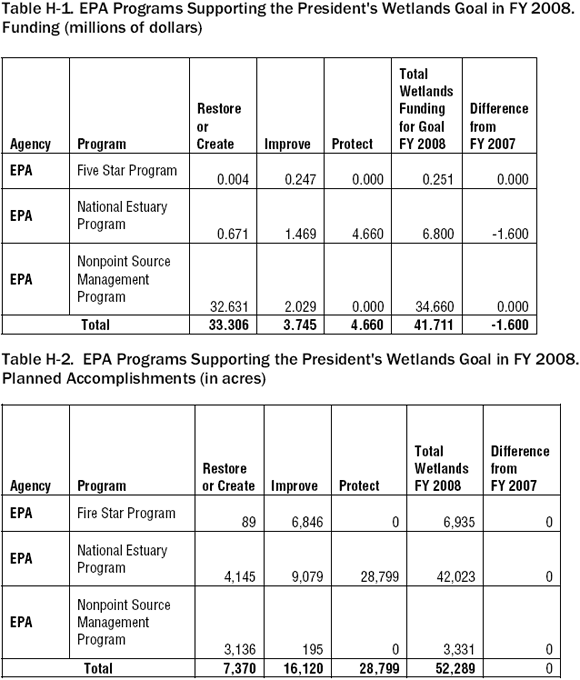Conserving America’s Wetlands 2007:
Three Years of Progress
Implementing the President’s Goal
Appendix H.
Environmental Protection Agency

EPA Programs Supporting the President’s Wetlands Goal
Five Star Challenge Grants Program: EPA and its
partners—National Fish and Wildlife Federation, National
Association of Counties, Southern Company, and Wildlife
Habitat Council—have helped catalyze over 400 projects in all
50 states, the District of Columbia, and the U.S. Virgin Islands.
Each year, 50 to 60 grants of $5,000 to $20,000 are awarded.
The purpose of the Five Star Restoration Program is to support
community-based efforts to restore wetlands, river streams/corridors, and coastal habitat; build diverse partnerships within
the community; and foster local stewardship of resources
through outreach.
http://www.epa.gov/owow/wetlands/restore/5star
National Estuary Program (NEP): This program works
to restore and protect these sensitive and vital ecosystems. The
NEP provides funding and technical assistance to citizens,
governments, businesses, researchers, and organizations in
local communities to create and implement plans they develop
collectively. These plans address problems facing their estuaries,
such as excess nutrients, pathogens, toxic chemicals,
introduced species, overfishing, and habitat loss and degradation.
With its partners, the NEP works to safeguard the health of
some of our Nation’s most productive natural resources and
transfers the lessons learned to other watersheds.
http://www.epa.gov/owow/estuaries
Nonpoint Source Management Plan: Under Section
319 of the Clean Water Act, states, territories, and Indian tribes
receive grant money that supports a wide variety of activities,
including technical assistance, financial assistance, education,
training, technology transfer, demonstration projects, and
monitoring to assess the success of specific nonpoint-source
implementation projects, some of which include wetlands
restoration projects.
http://www.epa.gov/owow/nps/cwact.html
EPA Programs that Maintain the Wetlands Base
Wetlands Grants Program: The EPA annually has
provided $16 million to states, local governments, tribes, and
nongovernmental organizations to strengthen and build
comprehensive non-Federal regulatory and nonregulatory
wetlands programs. FY 2008 funding request is $16.8 million.
http://www.epa.gov/owow/wetlands
Clean Water Act Section 404 Program: EPA and USACE
share regulatory responsibility pursuant to CWA Section 404.
EPA and USACE establish the regulations and policies for
implementation of the program, including development and
implementation of the Section 404(b)(1) guidelines. The
guidelines establish the substantive environmental criteria used
to evaluate applications for permits to discharge under Section
404. FY 2008 funding request is $21.5 million.
http://www.epa.gov/owow/wetlands/
Ecological Research Program: One of several components
of this Office of Research and Development program, the
Environmental Monitoring and Assessment Program (EMAP)
conducts research on the design, methods, and analysis used in
the assessment of the ecological quality of the Nation’s waters,
including wetlands. EMAP partners with states and tribes to
demonstrate how assessments of wetland condition can be
conducted and how the results can be used to report on the
effectiveness of protection and restoration actions. EMAP
currently has $1.1 million in pending awards for assessments of
wetland condition in the Mid-Atlantic and Southeast, and has
set aside $1 million of FY 2007–2008 dollars to fund wetland
projects in states in the Midwest and West. In addition, technical
assistance is being provided in support of the 2011 National
Wetland Survey, including the funding of a pilot assessment of
coastal wetlands in the Gulf of Mexico region. Other technical
assistance, including transfer of research and training, is being
provided to states and tribes to aid in the development of
wetland monitoring and assessment programs. The overall
research program will also increasingly focus on the ecosystem
services provided by wetlands at multiple scales within the
context of their condition.
http://www.epa.gov/ord










